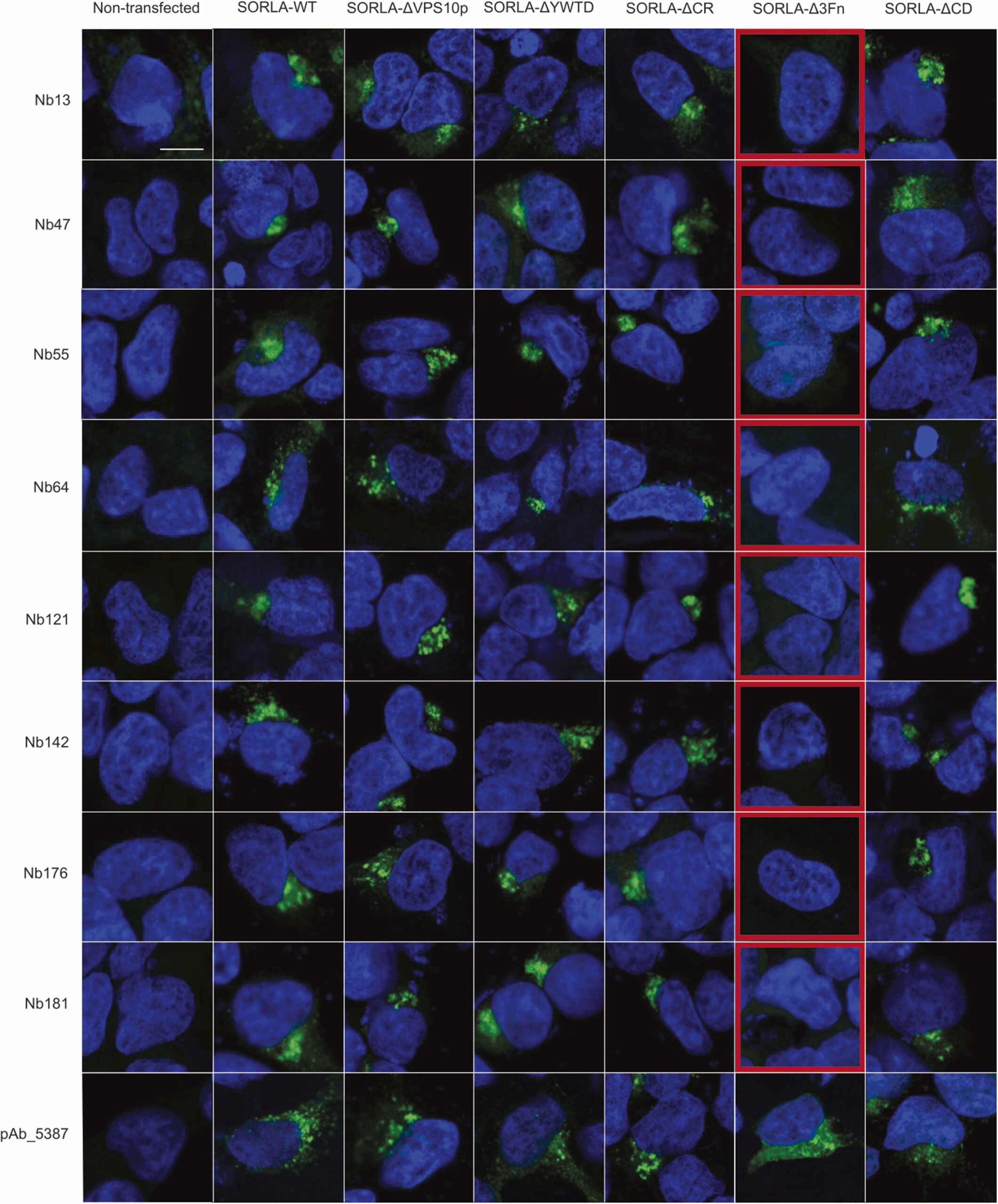Content #1
Content #1
Content #1
Sortilin-related receptor with A-type repeats (SORLA) is a transmembrane protein receptor that binds specific peptides and integral membrane protein cargo in the endolysosomal pathway. It then delivers them to the retromer, a multiprotein complex involved in endolysosomal protein sorting. Predominantly expressed in the central nervous system, reduced levels of SORLA have been associated with Alzheimer’s disease. In fact, endosomal bottlenecks linked to retromer dysfunction are the earliest cellular pathology in both familial and sporadic Alzheimer’s patients (Small et al., 2017). Single-domain antibodies, also known as NANOBODIES® (Nbs), are normally derived from the heavy-chain-only antibodies of immunized camelids and display several advantages over other antibodies, including reduced aggregation and enhanced antigen affinity. Thus, the production of a suite of well-defined SORLA-specific Nbs would represent valuable tools for research, diagnostic, and, potentially, therapeutic applications.
In a brand-new Journal of Biotechnology article, Monti et al. report the production and characterization of eight novel high-affinity Nbs identified from the blood of an alpaca immunized with the recombinant extracellular domain of SORLA. Following six weekly immunizations with purified extracellular SORLA (residues 54–2107), lymphocyte RNA was purified, reverse-transcribed, and the VHH cDNA sequences (variable region of heavy-chain antibodies) tagged and electroporated into E. coli cells. A representative fraction of the resulting library was then screened via phage display to identify clones producing highly SORLA-specific Nbs. A preliminary surface plasmon resonance (SPR) run was then used to identify the 8 Nb extracts with the slowest koff rates for use in further experiments. In more detailed SPR experiments, these eight Nbs showed high affinity to SORLA in the low nanomolar range. The team then transfected HEK293 cells with a panel of SORLA constructs for mapping of the Nbs’ epitopes within the antigen. SORLA Nbs were conjugated with Biotium’s CF®488A fluorophore using the Mix-n-Stain™ Nanobody Labeling Kit and applied to the transfected cells overnight (Figure 1). Using this method, Monti et al. showed that all Nbs in the panel specifically recognize a part of SORLA containing Fibronectin-type III domains. The high-affinity SORLA-specific Nbs characterized by the group will be valuable for future researchers and could be potentially used in diagnostic applications targeting SORLA.
 Figure 1. Epitope mapping of SORLA by immunostaining using eight fluorescently-labeled Nbs. HEK293 cells transfected with SORLA-WT or with the SORLA deletion constructs shown above each column were stained with SORLA Nbs directly conjugated with CF®488A fluorophore (green, DAPI in blue). A negative signal indicates the presence of the respective epitope in the deleted domain (highlighted in red). Scale bars = 10 µm. Credit to Monti et al. https://doi.org/10.1016/j.jbiotec.2023.08.005 reproduced under the Creative Commons license (CC BY 4.0).
Figure 1. Epitope mapping of SORLA by immunostaining using eight fluorescently-labeled Nbs. HEK293 cells transfected with SORLA-WT or with the SORLA deletion constructs shown above each column were stained with SORLA Nbs directly conjugated with CF®488A fluorophore (green, DAPI in blue). A negative signal indicates the presence of the respective epitope in the deleted domain (highlighted in red). Scale bars = 10 µm. Credit to Monti et al. https://doi.org/10.1016/j.jbiotec.2023.08.005 reproduced under the Creative Commons license (CC BY 4.0).
Learn more about Mix-n-Stain ™ Nanobody Labeling Kits designed for optimal labeling of Nanobodies® with one of Biotium’s high-performance CF® Dyes.
Full Citation
Monti, G., Vincke, C., Lunding, M., Jensen, A. M. G., Madsen, P., Muyldermans, S., … & Andersen, O. M. (2023). Epitope mapping of nanobodies binding the Alzheimer’s disease receptor SORLA. Journal of Biotechnology. https://doi.org/10.1016/j.jbiotec.2023.08.005
Other References
Small, S. A., Simoes-Spassov, S., Mayeux, R., & Petsko, G. A. (2017). Endosomal traffic jams represent a pathogenic hub and therapeutic target in Alzheimer’s disease. Trends in neurosciences, 40(10), 592-602. https://doi.org/10.1016/j.tins.2017.08.003
NANOBODY is a registered trademark of Ablynx, a Sanofi company.